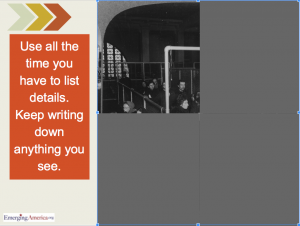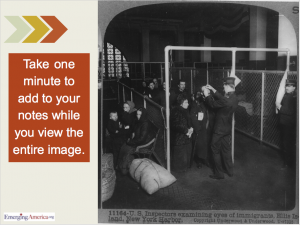
A way to spur inquiry and close observation is by examining one quarter of the primary source at a time.This six-minute exercise gives students a chance to focus in on particular details of the source. Having students write notes about each quadrant helps students to generate ideas and text fragments they can use in their writing; the partial view makes it easier for students to make notes without self-criticism. The process is a way to introduce students to the benefits of taking their time when interpreting sources, and to finding tools to delay drawing conclusions before looking closely and noticing as much as possible.
You must choose an image that contains sufficient detail to merit such close analysis. Note that the technique originated among art historians.
Introduce this exercise by showing an image for the first time without a caption or identifying information, for only 60 seconds, asking students to write nothing, just look at the image. After the 60 seconds in which students are shown the whole image, show just one quarter of the image for 60 seconds, and encourage students to write what they see.
Once the six-minute exercise is complete, students can share observations with a partner, and perhaps complete other tasks, depending on the teaching goals. For example:
- What are the three most important details you and your partner noticed?
- What was unique in each quarter? How did the divided image differ from the whole?
- If you were to give this image a title, what would it be?
- Write a thought bubble for a person in this image? What are they thinking?
In a whole class discussion, partners can share observations. A powerful engagement strategy is for teams to post titles or thought bubbles on the board for all to see. The teacher will decide the right point to share the full citation and any other contextual information for the image. (In example, Library of Congress: https://www.loc.gov/item/97501532/.)
Discussion can turn to the historical particulars of the image, including
- Who is the audience for this image? Who made it, and why?
- What other questions do you have about this image? What would you need to know to understand more about it?
The exercise can serve as an introduction to new content or new methods, or as an opportunity to deepen examination of a particular point of view.
Technical note: Create the quartered image in PowerPoint or Google Slides by creating a single rectangular "shape," and coloring it black. Copy the slide three times, moving the rectangle to a new quarter.



